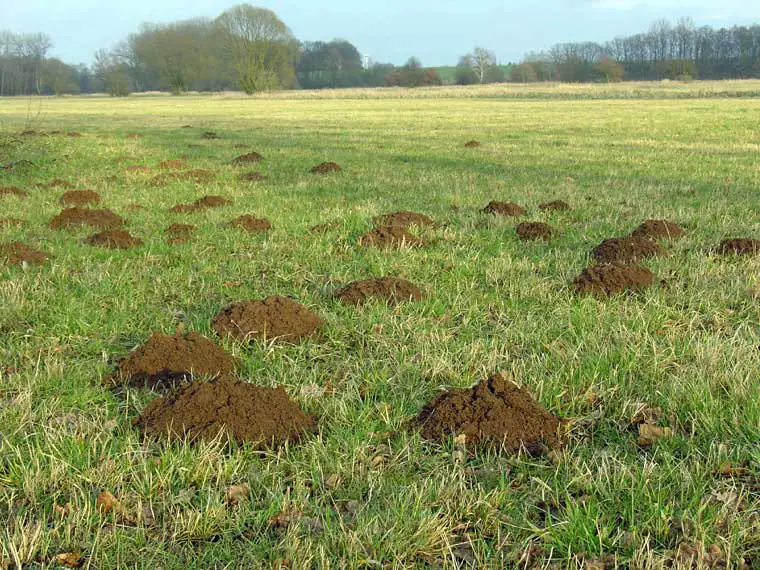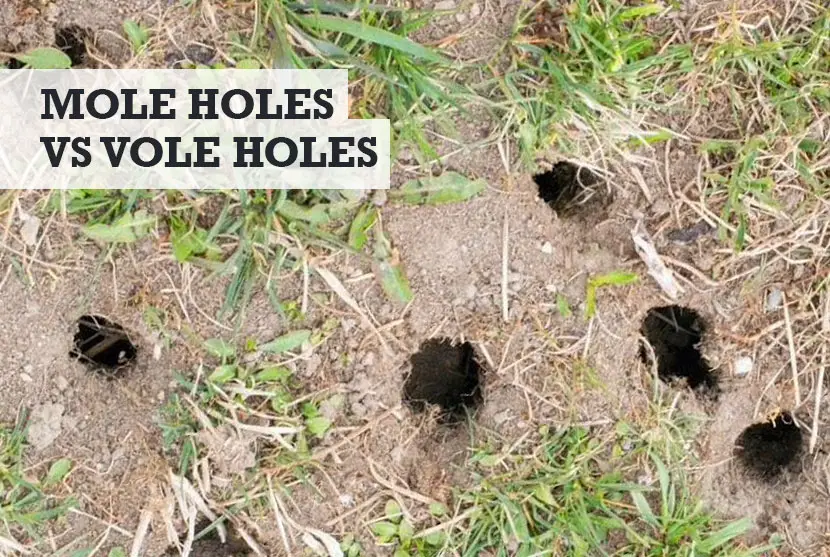It’s never a welcome sight to see critter holes and mounds appearing in your backyard. Whether it’s a mole, vole, or even a gopher, all can and do cause damage to gardens and lawns.
But the scale of their damage depends on certain factors, which is why it’s helpful to understand the difference between a mole hole and a vole hole.
Differentiating mole holes vs vole holes is actually very simple. Moles will leave circular mounds of dirt over their holes, often compared to a volcano or cone shape. In truth, you won’t see a physical mole hole because it’s covered with dirt.
Voles on the other hand do leave very visible holes and never leave mounds. A vole hole will be open and obvious on the yard lawn, whereas a mole hole is a mound of dirt. It will also be small, sometimes compared to the size of a golf ball or quarter coin.
However, mole mounds can be mistaken for those made by a gopher and vice versa (gopher vs mole vs vole holes are shown lower down the page).
What vole holes look like in your yard
- Vole holes do not have mounds of earth outside them like mole holes do.
- Voles are about the size of a golf ball, and just under 2 inches in diameter.
- They are found on yards and lawns and often around the base of trees.
- You might also notice tracks that about 2 inches wide in the lawn where the voles are travelling between holes.
- Look for gnaw marks near the bottom of trees, bark, or plant stems.
- Look for dead plants that have had their roots eaten.
- Vole tunnels can go as deep as 12 inches into the earth.

What mole holes look like in your yard
- No visible mole hole.
- Mound of earth piled up in a volcano or rounded cone shape.
- Might see a network of tunnels evident near the surface of your lawn.
- Moles don’t eat plants.
Hopefully that will quickly settle any debate you are having on the vole vs mole holes debate. Just bear in mind: small holes could equal voles, no holes, but a mound instead, could equal moles!
Whilst that settles the mole holes vs vole holes argument, you still need to consider gophers as they have very similar holes to moles.
Gopher vs mole vs vole holes
If you’ve not been shown it’s not easy to tell the difference between vole and mole holes. That will now be simple, but the harder task is bringing gopher holes into the challenge.
But as with before, you can tell the difference between gopher vs mole vs vole holes by what mound (or not) that it makes.
Mole hills are very dome shaped and have no visible holes that will act as the exit or entrance point for the mole. Moles are underground piling up the dirt onto the lawn, so you won’t even see a hole. The highest spot will be in the centre, with dirt pushed out in all directions… which is what makes the mole mound circular in appearance.

Gophers will also leave mounds, but theirs are not as neat and round as a mole hill which tends to be domed in shape. Gopher holes tend to be asymmetrical and lop-sided.
With a gopher mound you will often see where a hole was, as it’s the low spot on the top of the soil which they have plugged back up with dirt when going back underground.
There is also a high crescent shape, or ridge which is created when gophers come up at an angle and kick dirt out from the back. By doing so, you only see the mound piling up to one side rather than a conical shape like a mole mound.
Sometimes gopher mounds will have open holes if the critter is coming in and out to look for food.
Other things to look out for when figuring the differences out between gopher vs mole vs vole holes is size of the dirt. Gophers leave bigger chunks of dirt, as moles tend to leave finer dirt.
Then as established, voles don’t make mounds like moles and gophers do at all. They make visible small holes about the size of a quarter with track runs leading to and from it in the grass. The holes remain open and don’t get plugged.
Voles and gophers will all damage the garden as will eat plants and veggies. Moles won’t eat plants but will eat insects instead. If you are not worried about their mounds and tunnels, you can leave them to it.
Handy Hint: Here’s the differences between rat vs mole holes.
Gophers will make extensive tunnels.
Here’s a quick primer to let you understand the difference between vole, mole, and gopher holes with a quick glance.
- Moles: Leave cone / round-shaped mounds and you might see their tunnels near the surface of your lawn. They also won’t have eaten plants.
- Voles: Visible holes similar in size to golf balls, and tracks running two and from the holes. Voles will also eat plants, strip bark, and diet on your bulbs.
- Gophers: Crescent-shaped mounds and dips in the mound where a hole has been plugged.
But you could have all three! I’d definitely get rid of gophers and voles though as they cause so much damage… if you want to get rid of them, here are tips.
How to get rid of critters in your yard
Here are 5 humane ways you can get rid of moles and gophers from your backyard.
- Electronic deterrents: this device on Amazon (click pic below) emits sonic pulses that you can’t hear, but moles can, and they are said to hate it and will leave your yard.
- Humane repellents: you can also buy granules on Amazon that you put in your yard, a mole will taste it, hate it, and hopefully move on sharpish!
- Netting: this is more preventative, as you place the netting underneath a lawn before it’s laid. It’s not a favorite of mine, as it’s adding plastic to the ecosystem of your yard.


